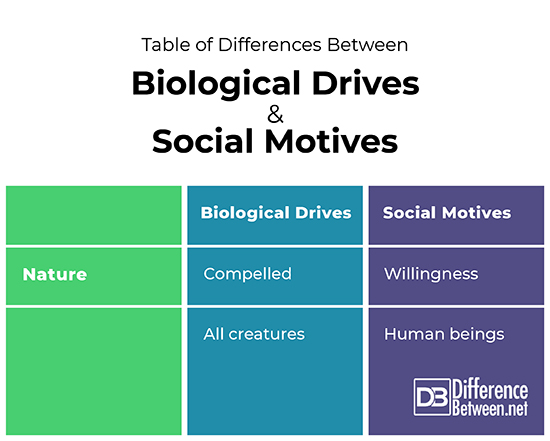Difference Between Biological Drive and Social Motive

When needs arise in organisms, such as the need to quench their thirst, satisfy their hunger, or achieve a goal, they are motivated or driven to fulfill that need. Motivation therefore concerns people or creatures starting, continuing, or ending behavior that is intrinsic (inherently rewarding or interesting), or extrinsic (offers an external reward) for the sake of fulfilling their needs (R. M. Ryan and Deci).
Psychologists categorize motives into three types: biological, social, and personal. Biological motives, also called physiological drives, arise due to a physical imbalance and are essential for survival (Arman Sharma). In other words, biological drives are innate motivational states resulting from depletion or deprivation of a needed substance (e.g., water, oxygen) and impel action to restore physiological equilibrium (American Psychological Association [APA]).
Social motives are said to be specific to human beings and are learnt and acquired in and through interaction in social groups (Arman Sharma). Some social motives are universal, for example, the need to belong, and others are culturally specific, for example, the need for achievement (APA).
Theorists disagree about just how many social motives there are. For example, according to Raghavendra Pras, some theorists identified as many as 17 types of social motives, whereas others identified just four: The need for achievement, the need for power, human aggression, and the need for affiliation or a sense of belonging.

The achievement motive is defined as the desire to be successful, to perform well, be seen as and feel capable, and maintain a standard of excellence. Its importance to a person is influenced by factors like independence, socio-cultural norms, past successes, and the sex of the person (Hans-Joachim Kornadt). The power motive is defined as the desire to influence, cajole, control, persuade, charm and/or lead others for the sake of enhancing one’s reputation. It may combine with the aggression motive and be expressed impulsively and aggressively or be channeled constructively into participation in sports. It may also include drinking and sexually dominating women, collecting possessions, and choosing occupations in which one is an authority. The need for affiliation or a sense of belonging relates to socializing and interacting with others, particularly peers, as well as pleasing others and winning their affection.
Unlike biological drives that ensure the survival of an organism, social motives are psychological processes that motivate a person’s feelings, thoughts, and behavior when interacting with other people. Throughout life, people are confronted with situations where their interests and preferences are different from or incompatible with the interests of others, and social motives help people decide to what extent they will value others’ interests in relation to their own interests (C. P. R. Folmer).
In modern psychological research on biological and social motives, research has shown that motives are not homogenous single phenomena as assumed by early drive and instinct theorists. Instead, motives are complex systems characterized by various components that interact in complex ways (Hans-Joachim Kornadt).
Table of Differences Between Biological Drives and Social Motives

Summary
Biological drives, such as thirst, hunger, and sleep, impel people towards their fulfillment because their lack of fulfillment would threaten the person’s survival. Social motives, such as the need to achieve, possess power, and belong, on the other hand, are based on what people value in their interactions with others and are characterized by a complex systems of components that interact in complex ways.
FAQ
What is an example of a social motive?
Examples of social motives include the need for affiliation or belonging, as well as the need for achievement, approval, power, and aggression.
What is an example of physiological drive?
Examples of biological or physiological drives include hunger, thirst, and sleep.
What are the 3 types of motives?
The three types of motives are biological or physiological drives, such as hunger, thirst, and sleep; social motives, such as achievement, power, and acquisition; and personal motives, such as habits, goals, aspirations, and interests. Motives may also be unconscious or repressed but nonetheless, influence behavior (Arman Sharma).
What is involved in social motives?
Social motives are a product of living in a world that is shared with others involves consideration of other’s needs relative to one’s own.
What are the five core social motives?
The five core social motives according to Susan Fiske are belonging, understanding, controlling, enhancing self, and trusting others. Other theorists include achievement, power, and human aggression, in addition to a sense of belonging.
What drives most biological evolution?
Biological evolution involves the changing inherited traits over successive generations in populations of organisms (William R. Jeffrey). Five forces are responsible for biological evolution: mutation or replication errors in the genes; natural selection, which changes traits in a population; gene flow or the exchange of genes between species; genetic drift or random changes in allele frequencies; and nonrandom mating, or mating among close relatives (Laura Higgins).
Can natural selection occur without evolution?
Natural selection, a central mechanism for evolution, can cause genetic drift without changing the DNA of a population. For example, the pepper moth changed from white to black with the first industrial revolution. With the transition to electricity during the latter part of the industrial revolution, the genetic drift for the pepper moth was back to a majority of white moths (David Dreyer).
What happens to a population when biological evolution takes place?
Populations of organisms are constantly influenced by mutations that create variations; non-random mating, which by virtue of preferring similar genotypes reduces variability; and genetic drift, which causes changes in a population by chance alone, resulting in evolution. In larger populations, genetic drift may be swamped by the stronger force of natural selection, but in small populations, genetic drift can change the population’s chances of survival (Biological Principles). Those individual organisms are best suited to an environment survive and reproduce successfully, producing many similarly well-adapted descendants.
How does natural selection work?
In natural selection, genetic mutations that are beneficial to an individual’s survival are passed on through reproduction. This results in a new generation of organisms that are more likely to survive and reproduce (Biological Principles).
- Difference Between Ecchymosis and Erythema - August 15, 2022
- Difference Between Autobiographical Memory and Episodic Memory - August 1, 2022
- Difference Between Biological Drive and Social Motive - July 30, 2022
Search DifferenceBetween.net :
Leave a Response
References :
[0]American Psychological Association. Dictionary. 2022. https://dictionary.apa.org/social-motive
[1]Biological Principles. Other Mechanisms of Evolution. n.d. https://bioprinciples.biosci.gatech.edu/module-1-evolution/neutral-mechanisms-of-evolution/#:~:text=Evolution%20by%20genetic%20drift%20causes,population%20in%20the%20current%20generation.
[2]Dreyer, David. How can Natural Selection Occur Without Evolution? Socratic Q&A Environmental Science. Apr. 1, 2017. https://socratic.org/questions/how-can-natural-selection-occur-without-evolution
[3]Folmer, Christopher P. Reinders. “Social Motives.” The SAGE Encyclopedia of Theory in Psychology, Vol. 2 (pp. 886‒890). Sage. June 2016. https://doi.org/10.4135/9781483346274.n303
[4]Fiske, Susan. Social Beings: A Core Motives Approach to Social Psychology, 4th edition. 2010. Wiley.
[5]Jeffery, William R. “Astyanax Mexicanus: A Vertebrate Model for Evolution, Adaptation, and Development in Caves.” In Encyclopedia of Caves (Third Edition, pp 85-93). 2019. Elsevier. https://doi.org/10.1016/B978-0-12-814124-3.00012-1
[6]Pras, Raghavendra. “4 Major Types of ‘Social Motives’ as Classified by ‘Murray’.” n.d. https://www.shareyouressays.com/knowledge/4-major-types-of-social-motives-as-classified-by-murray/116056
[7]Ryan R.M. and E.L. Deci. "Self-Determination Theory and the Facilitation of Intrinsic Motivation, Social Development, and Well-Being". The American Psychologist, 55(1): 68–78. January 2000. doi:10.1037/0003-066X.55.1.68.
